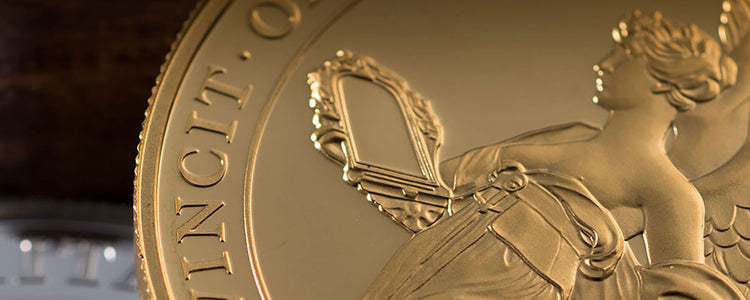The East India Company Collection’s new Faerie Queene coin series sees this epic medieval tale of honour, chivalry, love and virtue reimagined by one of the world’s leading coin designers, Joel Iskowitz.
First published in 1590, Edmund Spenser’s epic poem The Faerie Queene is a classic work of medieval English literature. At over 36,000 lines long, its six books contain one of the longest poems in the English language, believed to be an allegory for the life of Queen Elizabeth I.
Book One opens with a letter written by Spenser to Sir Walter Raleigh. Spenser explains to Raleigh how his tale has been influenced by the legends of King Arthur, and other great Classical epics such as The Illiad and The Odyssey. He describes how his story will be based around a festival, hosted by The Faerie Queene, called ‘The Feast of 12 Days’.
Across each of these 12 days Queen Gloriana, the Queene of Faerieland, will listen to appeals for help from her subjects who find themselves in trouble, and on each day she will select a worthy quest and assign it to one of her bravest knights. Each of these quests, and the knight to whom it is assigned, would be the subject of one of the 12 books that would make up Spenser’s complete work.
Ultimately, Spenser was only able to complete six of his intended 12 books, joined by a seventh unfinished chapter. Each book did focus on a specific quest as planned, with each knight being a personification of a particular virtue:
Book One; Redcrosse represents Holiness
Book Two; Sir Guyon represents Temperance
Book Three; Britomart, who represents Chastity
Book Four; primarily a continuation of the story of Britomart
Book Five; Sir Artegall, who represents Justice
Book Six; Sir Calidore, who represents Courtesy
This first coin in our series starts, as it should, at the beginning.
Una and The Redcrosse Knight coin collection
Book One tells the story of The Redcrosse Knight and the quest he is given by Queen Gloriana on behalf of the lady Una; to rescue her parents from the captivity of an evil dragon. Through the various trials and tribulations of his quest, he transitions from a young peasant boy to a brave and embattled knight called Redcrosse, an allegory for St George, the patron saint of England.
The story begins with Una arriving at the court of Queen Gloriana carrying a suit of armour upon which is painted a red cross. Also at court is a young peasant boy who has attended the palace to ask the Queen to give him the responsibility of a quest, so that he can prove his strength and virtue. Una is desperately sad, as her parents have been captured and taken prisoner by a vicious dragon in a faraway town, and she asks the Faerie Queene to assign one of her bravest knights to help her rescue them.
The boy sees his chance and volunteers for the task. Una is initially unsure, as she was hoping for a proven knight for such a personal and daring mission. But she considers his plea and says he can try on the armour she is carrying and, if it fits, she will grant him his wish. So the boy tries on the armour, and sure enough it fits him as if it were tailor made. Because of the armour’s distinctive design, Queen Gloriana dubs him ’The Redcrosse Knight’ and gives him the quest to rescue Una’s parents.
This first coin captures that moment in a classical design by celebrated coin and medal artist Joel Iskowitz, whose expressive style and detail reflect the essence of the illustrative storytelling of this period in history. Redcrosse sits upon his mighty steed with Una by his side, while in the distance we can see the subject of the adventures that lie before them; the ruthless dragon high on the wing, circling a faraway castle where Una’s parents are imprisoned and in fear for their lives.
“And eftesoones taking on him knighthood, and mounting on that straunge Courser, he went forth with her on that adventure”
And so their epic quest begins. Across the pages of Spenser’s storytelling, and the four coins that will capture their journey throughout this series, Una and Redcrosse encounter a fierce lion, a malevolent wizard and the vicious dragon itself, all along experiencing the highs and lows of victory, defeat, betryal, love and loss.
Una and St George, together at last
Not only does this stunning new coin set this epic story on its path, it also unites two iconic figures from the history of coin design on a single coin.
St George, here represented by The Redcrosse Knight, has taken pride of place on the United Kingdom’s most famous coin, The Sovereign, since the early 19th Century. Benedetto Pistrucci’s dramatic design shows St George on horeseback slaying a mighty dragon, the pivotal moment in his mythology and the subject of his quest in Spenser’s The Faerie Queene. Pistrucci’s design first appeared on Sovereigns of 1817 and just a few years later, in 1839, The Royal Mint’s Chief Engraver, William Wyon, created a new coin design to celebrate the first anniversary of the coronation of Queen Victoria.
Wyon, known for his neoclassical style, this time took his inspiration from more recent history. He used Spenser’s medieval story of Una and her encounter with a fierce lion to represent the young Queen Victoria guiding the might of the British Empire in a coin design that has since become known as one of the most beautiful ever to be struck.
There was something of a rivalry between Pistrucci and Wyon throughout their lives, so it is fitting that the two characters they are perhaps both most famous for are united here in this new, classical design by Joel Iskowitz.
Explore the full silver and gold coin collection and discover these illustrative stories of knights, princesses, honour, love and loss HERE.




 Ceylon / Sri Lanka
Ceylon / Sri Lanka Assam, India
Assam, India Japan
Japan Taiwan
Taiwan Nepal
Nepal China
China Kenya
Kenya Egypt
Egypt South Africa
South Africa


